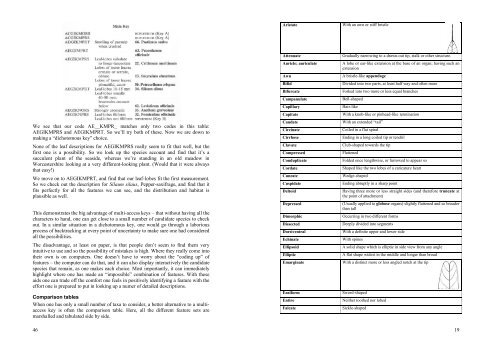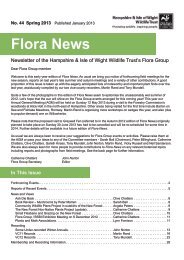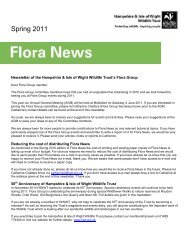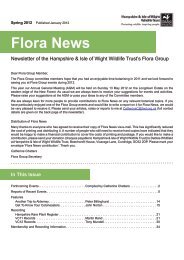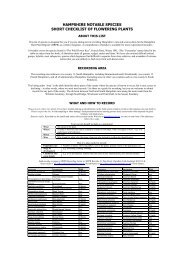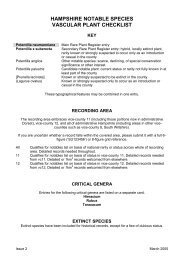An A5 booklet version as distributed in the - Hants Plants
An A5 booklet version as distributed in the - Hants Plants
An A5 booklet version as distributed in the - Hants Plants
Create successful ePaper yourself
Turn your PDF publications into a flip-book with our unique Google optimized e-Paper software.
We see that our code AE__KMPR_ matches only two codes <strong>in</strong> this table:<br />
AEGIKMPRS and AEGIKMPRT. So we’ll try both of <strong>the</strong>se. Now we are down to<br />
mak<strong>in</strong>g a “dichotomous key” choice.<br />
None of <strong>the</strong> leaf descriptions for AEGIKMPRS really seem to fit that well, but <strong>the</strong><br />
first one is a possibility. So we look up <strong>the</strong> species account and f<strong>in</strong>d that it’s a<br />
succulent plant of <strong>the</strong> se<strong>as</strong>ide, where<strong>as</strong> we’re stand<strong>in</strong>g <strong>in</strong> an old meadow <strong>in</strong><br />
Worcestershire look<strong>in</strong>g at a very different-look<strong>in</strong>g plant. (Would that it were always<br />
that e<strong>as</strong>y!)<br />
We move on to AEGIKMPRT, and f<strong>in</strong>d that our leaf-lobes fit <strong>the</strong> first me<strong>as</strong>urement.<br />
So we check out <strong>the</strong> description for Silaum silaus, Pepper-saxifrage, and f<strong>in</strong>d that it<br />
fits perfectly for all <strong>the</strong> features we can see, and <strong>the</strong> distribution and habitat is<br />
plausible <strong>as</strong> well.<br />
This demonstrates <strong>the</strong> big advantage of multi-access keys – that without hav<strong>in</strong>g all <strong>the</strong><br />
characters to hand, one can get close to a small number of candidate species to check<br />
out. In a similar situation <strong>in</strong> a dichotomous key, one would go through a laborious<br />
process of backtrack<strong>in</strong>g at every po<strong>in</strong>t of uncerta<strong>in</strong>ty to make sure one had considered<br />
all <strong>the</strong> possibilities.<br />
The disadvantage, at le<strong>as</strong>t on paper, is that people don’t seem to f<strong>in</strong>d <strong>the</strong>m very<br />
<strong>in</strong>tuitive to use and so <strong>the</strong> possibility of mistakes is high. Where <strong>the</strong>y really come <strong>in</strong>to<br />
<strong>the</strong>ir own is on computers. One doesn’t have to worry about <strong>the</strong> “cod<strong>in</strong>g up” of<br />
features – <strong>the</strong> computer can do that, and it can also display <strong>in</strong>teractively <strong>the</strong> candidate<br />
species that rema<strong>in</strong>, <strong>as</strong> one makes each choice. Most importantly, it can immediately<br />
highlight where one h<strong>as</strong> made an “impossible” comb<strong>in</strong>ation of features. With <strong>the</strong>se<br />
aids one can trade off <strong>the</strong> comfort one feels <strong>in</strong> positively identify<strong>in</strong>g a feature with <strong>the</strong><br />
effort one is prepared to put <strong>in</strong> look<strong>in</strong>g up a numer of detailed descriptions.<br />
Comparison tables<br />
When one h<strong>as</strong> only a small number of taxa to consider, a better alternative to a multiaccess<br />
key is often <strong>the</strong> comparison table. Here, all <strong>the</strong> different feature sets are<br />
marshalled and tabulated side by side.<br />
46<br />
Aristate With an awn or stiff bristle<br />
Attenuate Gradually narrow<strong>in</strong>g to a drawn-out tip, stalk or o<strong>the</strong>r structure.<br />
Auricle; auriculate A lobe or ear-like extension at <strong>the</strong> b<strong>as</strong>e of an organ; hav<strong>in</strong>g such an<br />
extension<br />
Awn A bristle-like appendage<br />
Bifid Divided <strong>in</strong>to two parts, at le<strong>as</strong>t half way and often more<br />
Bifurcate Forked <strong>in</strong>to two more or less equal branches<br />
Campanulate Bell-shaped<br />
Capillary Hair-like<br />
Capitate With a knob-like or p<strong>in</strong>head-like term<strong>in</strong>ation<br />
Caudate With an extended “tail”<br />
Circ<strong>in</strong>ate Coiled <strong>in</strong> a flat spiral<br />
Cirrhose End<strong>in</strong>g <strong>in</strong> a long coiled tip or tendril<br />
Clavate Club-shaped towards <strong>the</strong> tip<br />
Compressed Flattened<br />
Conduplicate Folded once lengthwise, or furrowed to appear so<br />
Cordate Shaped like <strong>the</strong> two lobes of a caricature heart<br />
Cuneate Wedge-shaped<br />
Cuspidate End<strong>in</strong>g abruptly <strong>in</strong> a sharp po<strong>in</strong>t<br />
Deltoid Hav<strong>in</strong>g three more or less straight sides (and <strong>the</strong>refore truncate at<br />
<strong>the</strong> po<strong>in</strong>t of attachment)<br />
Depressed (Usually applied to globose organs) slightly flattened and so broader<br />
than tall<br />
Dimorphic Occurr<strong>in</strong>g <strong>in</strong> two different forms<br />
Dissected Deeply divided <strong>in</strong>to segments<br />
Dorsiventral With a def<strong>in</strong>ite upper and lower side<br />
Ech<strong>in</strong>ate With sp<strong>in</strong>es<br />
Ellipsoid A solid shape which is elliptic <strong>in</strong> side view from any angle<br />
Elliptic A flat shape widest <strong>in</strong> <strong>the</strong> middle and longer than broad<br />
Emarg<strong>in</strong>ate With a dist<strong>in</strong>ct more or less angled notch at <strong>the</strong> tip<br />
Ensiform Sword-shaped<br />
Entire Nei<strong>the</strong>r too<strong>the</strong>d nor lobed<br />
Falcate Sickle-shaped<br />
19


